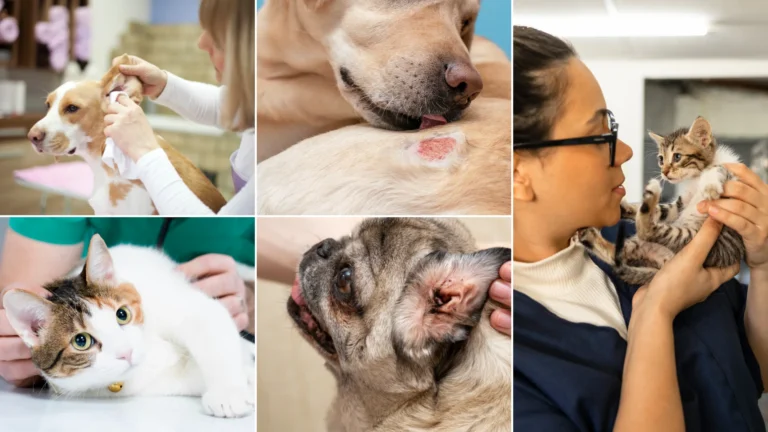Summer is the season for road trips, barbeques and of course, FUN! Involving our dogs is part of the festivities and bringing them along for the ride is something that most of us look forward to, but what about the potential risks that come with the rising temperatures and hot pavement?
If you’re wanting to enjoy your summer and include your canine companion, but also want to do so safely, then look no further! This article has you covered on how you can beat the heat with your pooch.

What Are The Summer Risks To Dogs?
Dogs are similar to people when it comes to major risks of hot summer temperatures, but keep in mind that they can’t sweat and they also can’t tell you that they’re too hot. This is why it is so important to keep an eye on your pet very closely during the summer months.
- Heat stroke
- Sunburns
- Insect and snake bites
- Burned or blistered paw pads
- Dehydration
While these problems are certainly not the only risks that there are to our dogs in the summer, these are the most common issues seen at emergency veterinary facilities associated with the heat. If you’re unsure if your dog (or cat) is drinking enough, check out this guide for how much water your pet should drink.
How Hot Is Too Hot?
A dog’s normal body temperature is typically around 101.2℉-102.5℉. This means that most ambient temperatures feel hotter to dogs already, so if it’s too hot to you, then it’s definitely too hot for them!
An easy way to understand the ideal temperature range for dogs is to look at the thermoneutral zone (TNZ), which is where dogs and other animals can maintain their body temperature without having to adjust for heat production or heat loss.
For a canine, this temperature range is between 68℉-86℉. Any temperatures more than 86℉ begin to pose a risk to your dogs safety.
Is It Too Hot For The Car?
It’s a good rule of thumb to not leave your dog in a car, even with the windows down slightly, once the temperatures outside reach the mid-70’s. It doesn’t take long for the inside of a car to become hot and once the temp rises into the 80’s it only takes 10 minutes for the vehicle to reach over 100℉. A little after 20 minutes and the car will be over 120℉! In direct sunlight, this can be even faster!
Even if you leave the car running with the air conditioning on, it is still extremely dangerous to leave your dog unsupervised in a car when the temperatures are in the upper-70’s. There have been cases where air conditioning failed or cars ran out of gas, causing life-threatening heat stroke or even death in dogs left in cars.

Brachycephalic Breeds And Overheating
A “brachycephalic breed” is a breed of dog that has a very short nose, such as a pug, bulldog, french bulldog, boxer, shih tzu, and a few others. Their short muzzles frequently come alongside an elongated soft palate and pinched nostrils, making it quite difficult for them to cool down through the normal method of panting.
When it comes to understanding what temperatures are dangerous for a brachycephalic breed, it is safe to assume that they will not be able to tolerate as much time outside as other breeds with longer noses.

What Are The Signs Of Heatstroke?
Heat stroke is a general and more commonly used term for hyperthermia, which is an elevated body temperature. With a normal body temp for a dog being around 101.2℉-102.5℉, anything exceeding 103℉ is considered abnormal or hyperthermic.
A dog that is suffering from heat stroke will start with an increased breathing rate and potentially the following:
- Dry, sticky guns
- Brick red gums
- Severe lethargy
- Disorientation or confusion
- Seizure
What To Do If Your Dog Is Overheated
The first thing to do is contact your veterinarian or an emergency veterinarian as heat stroke requires immediate attention. In the meantime, while you are working on getting your dog to the vet, you can apply room temperature or cool (not icy/cold) water onto their stomach, feet and armpits. Cooling too rapidly can potentially make things worse, so be cautious with how aggressively you try to cool your dog off.
Cool, continuous airflow should also be kept on the dog during this time, such as a fan.
Avoid using ice packs on their skin as this can constrict blood flow to areas that need to expel heat.
Once at the veterinarian, they will assess the severity of the hyperthermia and provide treatment from there. It is likely your dog will need to be monitored and kept on intravenous fluids with their temperature checked frequently. They may also need bloodwork to check for more serious physiologic consequences of heat stroke.
The prognosis of heat stroke depends on how high the dog’s body temperature was and for how long. Once their temp stays at 107℉ or higher for more than a very short period of time, we begin to see total organ failure and an increased mortality rate.

How To Keep Your Dog Safe In The Summer
Safety is really about understanding when it’s too hot for your dog to be exposed to the summer heat. If you have a brachycephalic breed, this is even more important.
- Do not leave your dog outside when the temperatures reach the mid-80’s for more than 20-30 mins at a time. Shorten that time frame even further as the temperature rises. If you’re hot, your dog is probably hotter!
- Always provide your dog with ample shade and water. A dog house does not count as these tend to retain heat and humidity- make sure there is adequate airflow wherever your dog is hanging out
- Only walk your dog during the early morning or late evening hours when the sun’s heat is less intense.
- Provide your dog with a small kiddie pool or other shallow water for them to cool off in.
- Avoid walking on hot asphalt as this can burn their paw pads. If you like to walk in the evening, be sure to check the pavement as it may remain quite hot even after the air has cooled a bit.
- Do not strenuously exercise your dog during the hot summer days. If you must, you should wait until the evening hours or early morning when it is less hot. Swimming or playing outside in a sprinkler can be a good activity for getting your dog’s energy out without as much risk of overheating.
- Do not leave your dog unattended in a car, even with it running, when the temperatures are in the mid-70’s or higher.

A Few Extra Summer Tips
Be aware of the plants in your home and area as there are always potentially toxic ones lurking in the environment. The sago palm, tulips and lilies are popular and common plants that are known for their extremely toxic and deadly nature when it comes to our canine and feline companions. Check out this longer list of toxic plants here!
Keep your dog on a reputable and reliable flea and heartworm prevention all year, but especially during the summer. Dogs are easy targets for nasty pests like fleas, ticks, sand lice and mosquitoes.
Conclusion
The first step to keeping your dog safe is simply knowing what to look out for. We encourage you to go on adventures and make memories with your dog, but be sure that you are prepared for the weather and elements. And if you can’t take your dog with you inside then it’s definitely better to leave them at home than inside the car!
Before you go – If you enjoyed this post, you probably love pets as much as we do! Did you know that you can sponsor a pet in need each month with a Nose to Tail Team donation and receive a limited-edition tote bag? Join our Nose to Tail Team and help a pet family get the care they need each month for just $0.54 a day.






